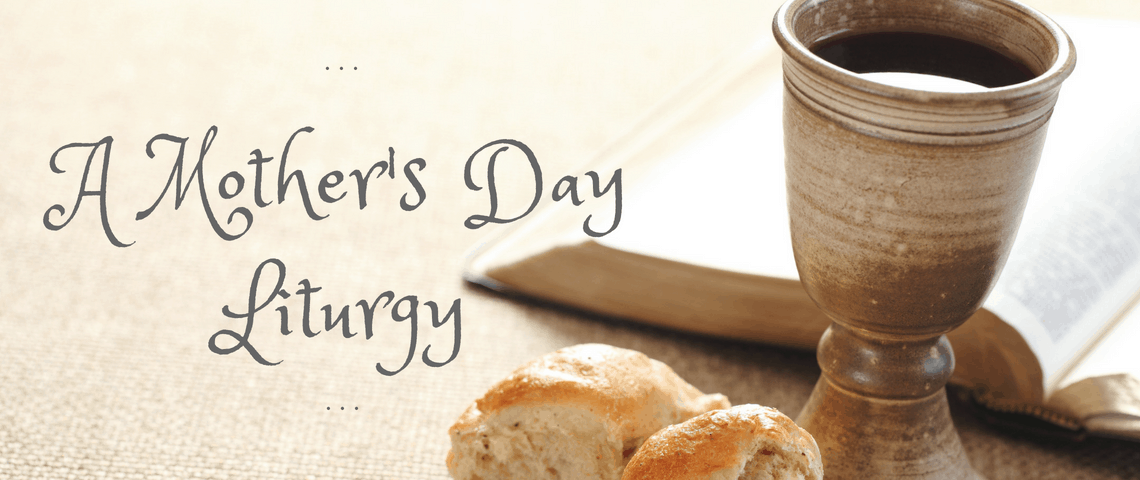
In recent years I have been struck by how feminine communion is
At the Last Supper Jesus says, “This is my body broken for you” & “This is my blood shed for you” and all of it is to bring about new life. How similar to what a mother can say to the baby she just birthed. For a mother’s body is also broken and her blood is also shed to make way for new life.
Did these words first find their origin on the lips of Jesus’ mother, as she cradled her newborn baby, telling him of all she went through to bring him new life?
Did they find their way back to her lips as she shouted in anguish, holding the nail-pierced & broken body of her son at the foot of the cross?
In many church traditions women are not allowed to preside over the communion table, or to help serve communion to the congregation. There are a few different reasons given, but I believe the story of Mary shows us that God had a different plan in mind.
After all, it was Mary who first presided over the body & blood of Jesus as she carried him in her womb for 9 months.
And it was Mary who delivered his body & blood into the world, for the benefit of all creation.
Yes, in recent years I have been struck by how feminine communion is. And every time I get to receive communion from a woman at church, I am reminded that my God isn’t afraid of being perceived as having feminine characteristics and doesn’t stray away from showing sacrificial, motherly love.
On Mother’s Day we want to honor all the women in our midst
Those who are birth mothers, adoptive mothers, foster mothers, stepmothers, and those who might not have children in the traditional sense, but who are spiritual mothers, nurturing and growing others in the faith. Motherhood takes on many different forms, but all of them sacrifice to bring about new life.As such, we present a Mother’s Day Communion Liturgy inspired by and adapted from the work of Samuel Wells & Abigail Kocher’s beautiful book, Eucharistic Prayers. (Kate will be using this at her church as she presides over communion this Sunday.) We pray it brightens your Mother’s Day!
A Mother’s Day Communion Liturgy
Introduction
As today is Mother’s Day, we’re going to be doing communion a little differently – drawing on the feminine imagery of the communion table. Jesus says, “This is my body broken for you” & “This is my blood shed for you” and all of it is to bring about new life. How similar to what a mother can say to the baby she just birthed. For a mother’s body, too, is broken; and her blood, too, is shed to make way for new life.
Invitation
As we ponder this, let us remember the sacrifice Jesus made, and make our humble confession before God.
Confession
Cradling God,
Unto whom all hearts are open, all desires known, and from whom no secrets are hidden. Cleanse the thoughts of our hearts by the inspiration of the Holy Spirit, that we may perfectly love you and worthily magnify your holy name, through Christ our Lord. Amen.
Absolution
Now hear these words of absolution…
God is our loving parent, who extends forgiveness to those who ask for it, and like a mother hen gathering her chicks, draws the weary and the lost to the abundant table of life.
Thanks be to God.
Table
On the night Jesus was betrayed he took the bread, and after giving thanks broke it and gave it to his disciples saying, “This is my body broken for you. Take and eat and as often as you do, do so in remembrance of me.
Likewise, Jesus took the cup and blessed it and said, “This is my blood of the new covenant shed for you for the forgiveness of sins. Take and drink. As often as you do, do so in remembrance of me.”
Prayer Over Elements
Loving God,
Like a mother, you brought all things into being. Through trial and truth-telling, touch, and tenderness, you nurture your people and lead us in the ways of justice and peace. Send your Holy Spirit upon this bread and this cup, that they may be for us the body and blood of Christ, so that we may be the body of Christ incarnate in this world, redeemed by Christ’s blood. Amen.
Happy Mother’s Day!



17 responses to “A Mother’s Day Liturgy”
One morning during Bible study I asked why women can’t serve the Lord’s Supper since they do so without speaking (thus not violating “women should be silent”) and they would be in a servant position (thus not “usurping the authority” of men). I was told that outsiders might not understand and think the women were in leadership and because it might encourage some of the women to ask to be allowed to do more (allow them to serve communion today and next week they will want to pray and the next week they will want to preach- where will it all end?). It is hard to even know where to begin to answer objections that basically come down to “It might look bad” and “women have no self-control”.
That’s so interesting. I believe there is remarkable biblical precedent for women to serve communion. But I also believe there is overwhelming biblical support to encourage women to pray, teach, & preach as well 🙂
Even among those people who believe that women must remain silent in worship and must not be in authority there should be support for allowing them to serve the Lord’s Supper. When a man serves a woman the man becomes the servant and the woman is the master. If the reasoning was consistent, the people wanting women to remain quiet and submissive would expect women to serve the men.
Yes, we miss the point when we become concerned about “authority” in the Church – that’s not what we are called to! Scripture calls us to imitate Christ in humbling ourselves, considering others as more valuable than ourselves, and looking not to our own interests but those of others (Philippians 2.1-11).
Beautiful perspective, Kate. A shining example of what the church is missing by not welcoming the teaching of godly women.
Thank you Timothy!
Kate,
What a beautiful liturgy and intro with your thoughts. Thank you!
Stephanie
Thanks Stephanie!
The striking similarity of meaning in those phrases never even occurred to me. Communion will never be the same for me, but more meaningful and personal. Until now, I had a pretty standard mental picture of Jesus in a roomful of other men (that’s the mental picture you get at Christian schools, and it’s the artwork you see too). This way, I’m in the room too, and not just somewhere in the background, but in the center, with all the other believers. Thank you.
“This way, I’m in the room too, and not just somewhere in the background, but in the center, with all the other believers.” – beautifully said Terri!
This is so great! I never considered communion like this before and it makes a lot of sense. If we are going to improve the lives of women (especially in the church) we really need to see more of the feminine in the divine – if only to uphold the truth that we are all created in the image of God. Thank you for writing this.
Yes! The feminine imagery is there in scripture for those who want to see it! We’re just not used to thinking about scripture that way, so we have to retrain ourselves.
Well done Kate! I had the privilege of administering communion at our Easter sunrise service this year and it was very meaningful to me. God bless you as you continue to use your gifts for His glory.
Thank you Linda! I think serving communion is my favorite thing to do in service! I’m so glad it was meaningful to you!
Jesus said, “I am the bread of life.” He didn’t say, “I am the male of life.” All references to the Eucharist are about body, flesh, bread… nothing about XY chromosomes.
So true!